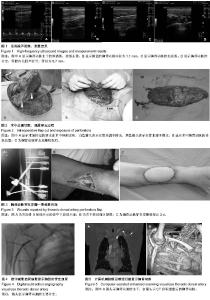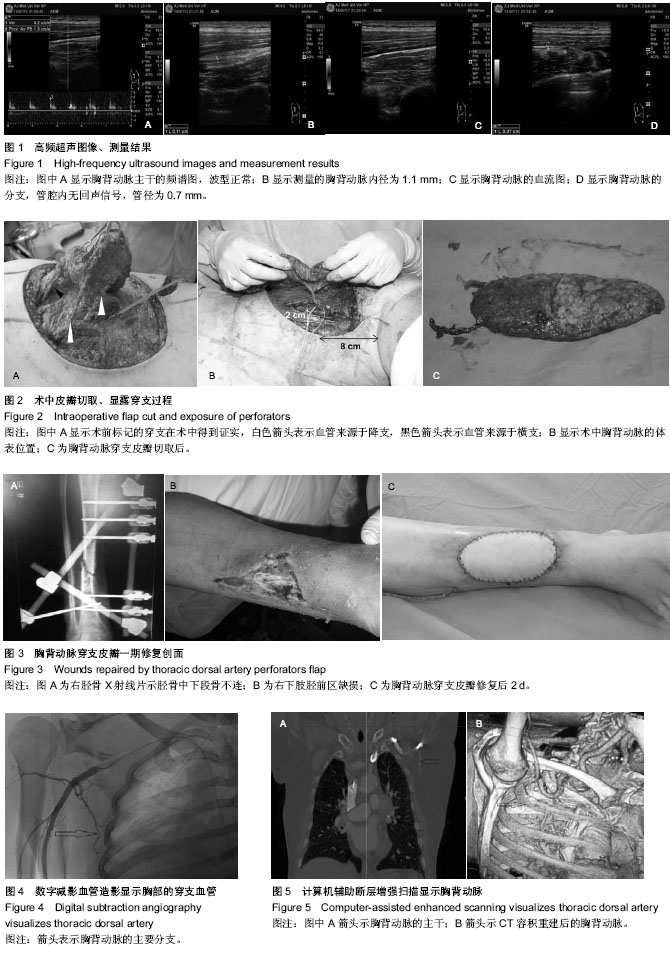| [1] 唐玉举.特殊形式穿支皮瓣的临床应用教程[J].中华显微外科杂志,2013,36(2):201-205.
[2] Hamdi M, Decorte T, Demuynck M, et al.Shoulder function after harvesting a thoracodorsal artery perforator flap.Plast Reconstr Surg. 2008;122(4):1111-1117.
[3] Schaverien M, Wong C, Bailey S,et al.Thoracodorsal artery perforator flap and Latissimus dorsi myocutaneous flap--anatomical study of the constant skin paddle perforator locations.J Plast Reconstr Aesthet Surg. 2010;63(12): 2123-2127.
[4] Koshima I, Narushima M, Mihara M,et al.New thoracodorsal artery perforator (TAPcp) flap with capillary perforators for reconstruction of upper limb.J Plast Reconstr Aesthet Surg. 2010;63(1):140-145.
[5] Sever C, Uygur F, Kulahci Y,et al.Thoracodorsal artery perforator fasciocutaneous flap: A versatile alternative for coverage of various soft tissue defects.Indian J Plast Surg. 2012;45(3):478-484.
[6] Amin AA, Rifaat M, Ellabban MA,et al.Transaxillary thoracodorsal artery perforator flap: a versatile new technique for hypopharyngeal reconstruction.J Reconstr Microsurg. 2014; 30(6):397-404.
[7] Pacifico MD, See MS, Cavale N,et al.Preoperative planning for DIEP breast reconstruction: early experience of the use of computerised tomography angiography with VoNavix 3D software for perforator navigation.J Plast Reconstr Aesthet Surg. 2009;62(11):1464-1469.
[8] Zou Z, Kate Lee H, Levine JL,et al.Gadofosveset trisodium-enhanced abdominal perforator MRA.J Magn Reson Imaging. 2012;35(3):711-716.
[9] Saba L, Atzeni M, Rozen WM,et al.Non-invasive vascular imaging in perforator flap surgery.Acta Radiol. 2013;54(1): 89-98.
[10] Gravvanis A, Tsoutsos D, Papanikolaou G,et al.Refining perforator selection for deep inferior epigastric perforator flap: the impact of the dominant venous perforator.Microsurgery. 2014;34(3):169-176.
[11] Pestana IA, Zenn MR.Correlation between abdominal perforator vessels identified with preoperative CT angiography and intraoperative fluorescent angiography in the microsurgical breast reconstruction patient.Ann Plast Surg. 2014;72(6):S144-149.
[12] Schaverien M, Saint-Cyr M, Arbique G,et al.Three- and four-dimensional arterial and venous anatomies of the thoracodorsal artery perforator flap.Plast Reconstr Surg. 2008; 121(5):1578-1587.
[13] Schaverien M, Wong C, Bailey S,et al.Thoracodorsal artery perforator flap and Latissimus dorsi myocutaneous flap--anatomical study of the constant skin paddle perforator locations.J Plast Reconstr Aesthet Surg. 2010;63(12): 2123-2127.
[14] 农剑波,李耀波,王宇飞,等.CTA、MRA、DSA在头颈部动脉瘤诊断的应用[J].中国当代医药,2012,19(7):99,101.
[15] Hoi Y, Ionita CN, Tranquebar RV,et al.Flow modification in canine intracranial aneurysm model by an asymmetric stent: studies using digital subtraction angiography (DSA) and image-based computational fluid dynamics (CFD) analyses.Proc Soc Photo Opt Instrum Eng. 2006;6143:61430.
[16] Rozen WM, Phillips TJ, Ashton MW, et al. Preoperative imaging for DIEA perforator flaps: a comparative study of computed tomographic angiography and doppler ultrasound. Plast Reconstr Surg. 2008;121(1 Suppl):1-8.
[17] Scott JR, Liu D, Said H,et al.Computed tomographic angiography in planning abdomen-based microsurgical breast reconstruction: a comparison with color duplex ultrasound.Plast Reconstr Surg. 2010;125(2):446-453.
[18] Zou Z, Kate Lee H, Levine JL,et al.Gadofosveset trisodium-enhanced abdominal perforator MRA.J Magn Reson Imaging. 2012;35(3):711-716.
[19] Kosutic D, Pejkovic B, Anderhuber F,et al.Complete mapping of lateral and medial sural artery perforators: anatomical study with Duplex-Doppler ultrasound correlation.J Plast Reconstr Aesthet Surg. 2012;65(11):1530-1536.
[20] Lin CT, Huang JS, Hsu KC,et al.Different types of suprafascial courses in thoracodorsal artery skin perforators.Plast Reconstr Surg. 2008;121(3):840-848.
[21] Lin CT, Huang JS, Yang KC,et al.Reliability of anatomical landmarks for skin perforators of the thoracodorsal artery perforator flap.Plast Reconstr Surg. 2006;118(6):1376-1386.
[22] Xiao H, Shi Y, Wang H,et al.Application of high frequency color Doppler ultrasound in anterolateral thigh flap surgery.Zhongguo Xiu Fu Chong Jian Wai Ke Za Zhi. 2013; 27(2):178-181.
[23] Su W, Lu L, Lazzeri D,et al.Contrast-enhanced ultrasound combined with three-dimensional reconstruction in preoperative perforator flap planning.Plast Reconstr Surg. 2013;131(1):80-93.
[24] 陆林国,徐智章,刘吉斌,等.超声造影增强技术在探索穿支皮瓣血管中的应用[J].上海医学影像,2010,19(3):161-164. |

